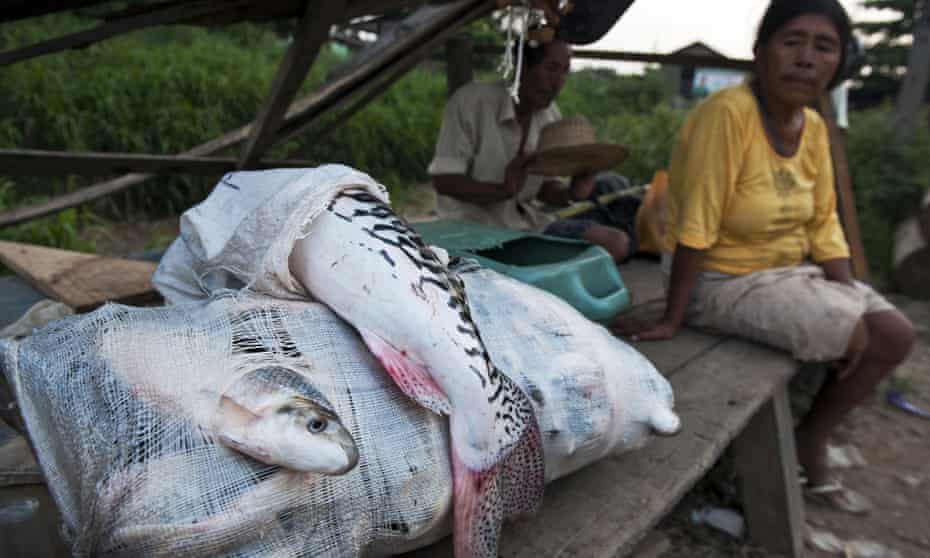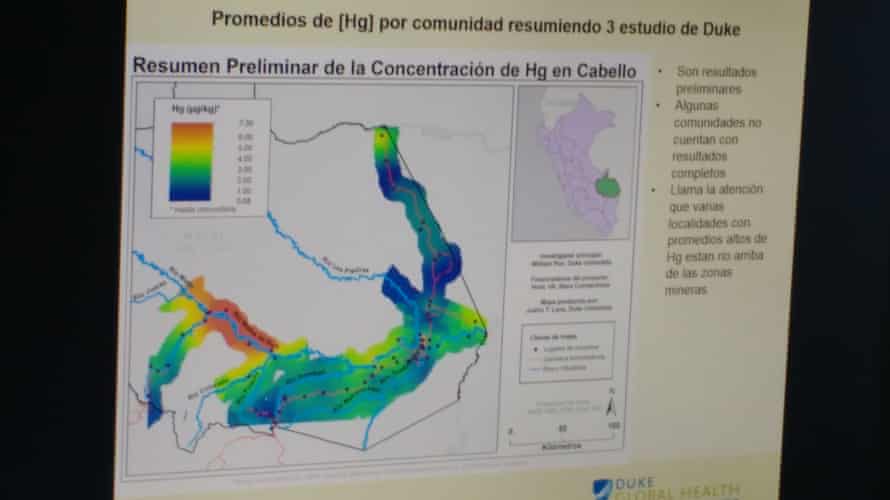Leaked map reveals chronic mercury epidemic in Peru
People living upriver from gold-mining are the most contaminated, according to US-based scientists

Fish from the River Madre de Dios in Peru. Fish consumption is considered one of the two main ways mercury contamination has spread among local inhabitants - including those living upriver from gold-mining. Photograph: Cris Bouroncle
Ask about the fish in restaurants in the centre of Puerto Maldonado, the biggest town in Peru’s south-east Amazon, and you’ll hear all kinds of things. Some people will shake their heads and say there isn’t any fish on the menu “because of the contamination” or “out of protocol”. Others might say there is fish available, before sometimes hastily clarifying that it comes from farms along the Inter-Oceanica Highway running to Brazil, or from the Pacific coast, or even, according to one chef, all the way from Vietnam.
Why such problems with the fish in this part of the Amazon? Answer: alluvial gold and the mercury required to extract it. The gold-rush in the 8.5m hectare Madre de Dios region began in the 1980s and, by 2012, miners had destroyed more than 50,000 hectares of forest, effectively dumping 100s of tons of mercury into the rivers while doing so. In May this year Peru’s outgoing government announced a pathetic 60-day “declaration of emergency”.
An image of a unpublished map obtained by the Guardian, based on “preliminary results” from studies of local inhabitants by the Duke Global Health Institute in the US, provides some idea of how widely-spread and severe the mercury contamination is across Madre de Dios. Arguably the map’s most alarming revelation is that the most contaminated area of all is upstream from the mining: the stretch of the River Madre de Dios between towns called Boca Colorado and Boca Manu, a significant part of which is in the buffer zone of the Manu national park, which Unesco calls the most biodiverse place on earth.
“It is noteworthy that some areas with high averages of mercury are upriver from the mining zones,” states the map, which was shown to Health Ministry officials earlier this year.
The map suggests the second worse-hit area is insidethe Manu park itself, immediately upriver from Boca Manu, along the River Manu’s left bank. The right bank is affected too. William Pan, the study’s lead researcher, told the Guardian “we didn’t sample people in Manu national park”, but explains the map on the basis that his teams have sampled several communities “along that bend of the river (Rio Manu/Rio Madre de Dios)” and “the map smoothing method creates a 10km buffer around the study sites and the exposure is extrapolated”.
How come people upstream are the most contaminated? Or maybe the mercury there has little or nothing to do with gold? As acknowledged by a 2011 report by the Environment Ministry, titled Gold-mining and Mercury Contamination in Madre de Dios: a Time-Bomb, mercury stored naturally in Amazon soil and vegetation is released when the forest is cut down or burnt and then leaches into the water.
as “very high” and says Madre de Dios is experiencing a “chronic mercury epidemic.” The contamination upstream was, he says, “the most surprising finding of our human Hg [mercury] assessment.”
“The communities near the confluence of Rio Manu and Rio Madre de Dios have the highest exposures in the region,” Pan told the Guardian. “When we tested fish, water and sediment, none of the values were high. So we were surprised when people were detected with high levels. We have several hypotheses that we are evaluating.”
According to Pan, those hypotheses are the people in that region migrate downriver to work in the mining, and that they are more dependent than the rest of Madre de Dios on local agriculture, fish and meat because there are no roads. Another is that “due to reliance on fish consumption, they are likely eat larger fish, which will have more Hg just naturally”.
Pan says the map was “supposed to be confidential with the Ministry of Health” because it is “unpublished data and we have not fully analysed all the samples,” calling it “very crude” and far from final. He told the Guardian it is based on three distinct studies conducted between May 2014 and June 2016, and the final results will include samples from almost 72 sites. He says the Health Ministry has “real monetary constraints right now due to expenditures of the prior ministry”.
Previous research by Pan and colleagues argued that mercury contamination is generating “significant health risks” for communities in Madre de Dios “hundreds of kilometres” downstream from the mining, particularly among children and indigenous people.
“Children living within the central portion of the [Madre de Dios] watershed cannot safely consume carnivorous fish without exceeding recommended international [mercury] body burdens,” stated an article by Pan et al in Environmental Science in January 2015. “Deforestation and mercury release are an immediate threat to both local and distant downstream communities, many of which do not benefit economically from [the mining].”
The law announcing Peru’s declaration of emergency in May stated that many people in Madre de Dios have “higher than the maximum recommended limits” of mercury, which causes “serious, chronic and complex health problems, particularly in children and pregnant women.”
“[M]ercury contamination of the air, water, sediment and fish is the result of inadequate practices by illegal and informal gold-miners during the extraction and working of alluvial gold,” the law stated. “In addition, there are people located beyond the mining extraction zones that are at high risk of being contaminated with mercury because of the high levels of it detected in the environment and in certain fish species, especiallyMota Punteada, which is part of the daily diet of Madre de Dios’s population.”
The social and environmental tragedy unfolding in Madre de Dios has been known about for many years: the Ministry of Environment dubbed it a “time-bomb” five years ago, but the bomb was ticking long before that. Will Peru’s new government, led by president Pedro Pablo Kuczynski, now take sincere, sustainable, non-violent steps to address the problem - not just in the Boca Manu region, obviously, but across Madre de Dios and Peru’s Amazon as a whole? What steps can the government take to initiate a massive public health campaign and inform those who are contaminated, or are at risk, and provide access to treatment – and if it doesn’t have the funds do so, who can provide them? What forms of alternative employment can be created, so those who find themselves forced to mine and handle mercury have other options? What steps can those buying, selling, hoarding, working and wearing Peruvian gold take to ensure they stop contributing to the devastation of huge swathes of the Amazon and the contamination of 1,000s of people living there?
The World Health Organization calls mercury “one of the top ten chemicals or groups of chemicals of major public health concern”, and states that human activity, including gold-mining and coal-fired power stations, is the “main cause of mercury releases.”
Peru is one of the world’s biggest gold producers, with the main importers being Canada, India, Switzerland, the UK and the US. A report published in April by the Global Initiative Against Transnational Organized Crime argued that 28% of all gold in Peru is illegal, with illegal gold-mining across Latin America increasingly controlled by drugs traffickers and “organized crime” groups.
In January Peru ratified the Minamata Convention on Mercury, a legally-binding global treaty which commits parties to regulate artisanal and small-scale mining, among other things, and states that “parties may cooperate with each other” to stop altogether the use of mercury or mercury compounds in such mining. Switzerland has ratified the Convention too, but not Canada, India or the UK.
Peru’s Health Ministry did not respond to questions
